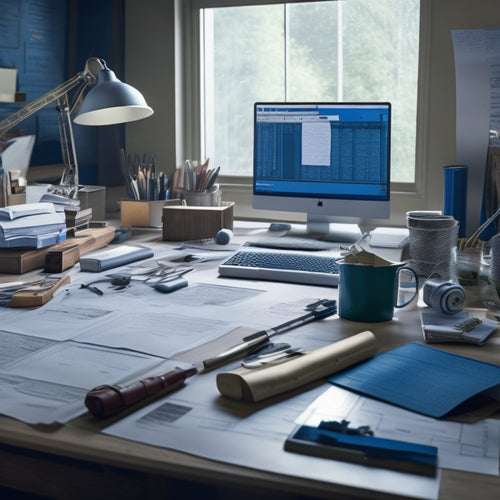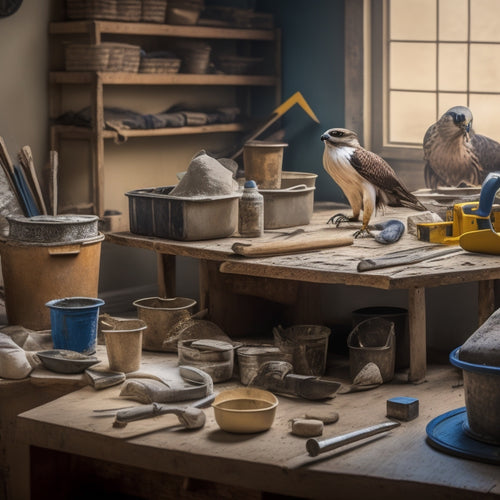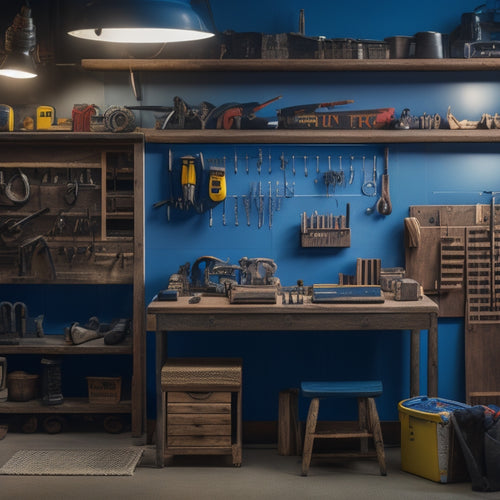
Why Only These Plaster Renovation Tools Matter
Share
You've been led to believe that any tool will suffice for plaster renovation, but the truth is that only a handful of essential tools can deliver professional-grade results. You need the right trowels for a smooth finish, precise mixing tools for consistency, sanding blocks for refined edges, and heavy-duty drilling machines for precise holes. Add to that safety gear for dust protection, a high-quality plastering hawk for even application, and a putty knife for finishing touches. With these tools, you'll be able to tackle demanding renovation projects with confidence - and now that you know what matters, you're ready to learn how to master them.
Key Takeaways
• Mastering essential plaster renovation tools ensures a professional finish and sets apart amateurs from experienced professionals.
• The right tools help achieve consistency, precision, and quality in every stage of the renovation process.
• Using the correct tools minimizes errors, reduces rework, and saves time, leading to cost-effective and efficient projects.
• High-quality tools provide durability, reliability, and safety, making them a worthwhile investment for any plaster renovation project.
• Familiarity with essential tools and techniques enables confidence in tackling complex projects and delivering exceptional results.
Essential Trowels for Smooth Finish
You'll consistently reach for a few essential trowels when aiming for a smooth finish in your plaster renovation project.
These must-haves will help you achieve a flawless, professional-looking result. First, you'll need a stainless steel trowel, ideal for applying and smoothing out plaster. Its rust-resistant material and curved blade make it perfect for scooping and spreading plaster evenly.
Next, a carbon steel trowel will become your go-to for finer details and finishing work. Its flexibility allows for precise control and a high-quality finish.
When it comes to trowel techniques, mastering the 'floating' method is key. Hold your trowel at a 20-degree angle and use long, smooth strokes to spread plaster evenly.
For a super-smooth finish, switch to a 'darby' trowel, which features a long, flat blade perfect for removing excess plaster and creating a uniform surface.
Plaster Mixing Tools for Consistency
With your trowel skills honed and a smooth finish in sight, it's time to focus on the other half of the equation: achieving consistent plaster mixes that meet your project's specific needs.
Consistency is essential in plastering, as it directly affects the final result's durability and appearance. To guarantee consistency, you need the right plaster mixing tools. A sturdy mixing bucket, a reliable drill, and a high-quality mixing paddle are indispensable for achieving uniform mixes.
Mastering mixing techniques is also critical. You should know how to accurately measure ingredients, mix in the right order, and avoid over-mixing. Remember, the key to consistency lies in precision and control.
Invest in a mixing stick with measurement markings to eliminate guesswork. By using the right tools and honing your mixing techniques, you'll be able to produce consistent, high-quality plaster mixes that meet your project's specific requirements.
Don't compromise on consistency – it's what sets professionals apart from amateurs.
Sanding Blocks for Smoothening Edges
Once you've applied a smooth layer of plaster, sanding blocks become essential for refining edges and creating a seamless connection between surfaces.
You'll need to master various sanding techniques to achieve a flawless finish. Sanding blocks are designed to tackle edges, helping you smooth out rough spots and create a uniform surface. When it comes to edge refinement, these blocks are your best friend.
To get the most out of your sanding blocks, start with a coarse grit and progress to finer ones for a polished finish.
Apply gentle to moderate pressure, depending on the surface and the level of refinement needed. Don't be afraid to experiment with different sanding patterns and strokes to achieve the desired effect.
Heavy-Duty Drilling Machines Needed
Heavy-duty drilling machines are essential for making precise holes in plaster surfaces, allowing for secure fastening of fixtures and fittings.
When you're working with plaster, you need a drill that can handle the density and hardness of the material. Anything less, and you'll be left with sloppy holes and loose fixtures. Invest in a high-torque drill that can deliver the power you need to get the job done efficiently.
Mastering advanced drilling techniques is imperative when working with plaster. You'll want to use a slow, controlled motion to avoid damaging the surrounding area.
Additionally, make sure you're using the correct drill bits designed specifically for plaster to prevent overheating and wear. Regular tool maintenance is also critical to extend the life of your drill and prevent downtime. Clean and lubricate your drill regularly, and store it in a dry, secure location.
With the right drill and techniques, you'll be able to tackle even the most demanding plaster renovation projects with confidence and precision.
Safety Gear for Dust Protection
When you're working with plaster, you'll be generating a lot of dust, and that's where your safety gear comes in.
You'll need to prioritize dust protection to avoid respiratory issues and eye irritation, so it's crucial to have the right equipment.
Now, let's take a closer look at the dust mask essentials and protective eyewear options that'll keep you safe on the job.
Dust Mask Essentials
Your respiratory system will thank you for investing in a quality dust mask, an essential piece of safety gear that shields you from airborne particles and dust generated during plaster renovation projects.
When choosing a dust mask, you'll encounter various types, including half-face, full-face, and disposable masks. Each type serves a specific purpose, so it's vital to select the right one for your project.
Here are a few key considerations to keep in mind:
Dust mask types: Half-face masks provide basic protection, while full-face masks offer superior protection for your eyes and skin. Disposable masks are ideal for short projects or when working with hazardous materials.
Fit and comfort: Guarantee a snug, comfortable fit to prevent air leaks and maximize protection.
Dust mask maintenance: Regularly clean and inspect your mask to confirm its effectiveness and extend its lifespan.
Protective Eyewear Options
As you commence on a plaster renovation project, don't underestimate the importance of protecting your eyes from airborne debris, which is where high-quality protective eyewear comes into play. You need gear that can withstand the harsh conditions of your work environment, and that's why we're highlighting the premier protective eyewear options for you.
| Feature | Description |
|---|---|
| UV Protection | Blocks 99.9% of UV radiation to prevent eye damage |
| Adjustable Safety Goggles | Customizable fit for ideal comfort and protection |
| Anti-Fog Coating | Reduces fogging for clear visibility in humid environments |
| Impact-Resistant Lenses | Withstands high-velocity impacts without shattering |
| Ventilation System | Enhances airflow to prevent moisture buildup |
When it comes to protective eyewear, you can't afford to compromise. Look for UV protection eyewear that offers superior defense against airborne debris and UV radiation. Adjustable safety goggles are also a must, as they provide a snug fit and ideal protection. Don't settle for anything less – your eyes are worth it. Invest in first-rate protective eyewear that meets your specific needs, and you'll be able to tackle even the most demanding plaster renovation projects with confidence.
Plastering Hawks for Easy Application
You'll find that using a high-quality plastering hawk is essential for efficient and uniform plaster application. This tool allows you to hold and distribute plaster evenly, making it easier to achieve a smooth, consistent finish. With a reliable hawk, you'll be able to work more efficiently and accurately, reducing the risk of errors and wasted materials.
When choosing a plastering hawk, consider the following key factors:
-
Material quality: Look for hawks made from durable, rust-resistant materials that can withstand heavy use.
-
Size and shape: Select a hawk that fits comfortably in your hand and is suitable for the size of your project.
-
Grip and balance: Opt for a hawk with a secure grip and balanced design, allowing you to maintain control and precision during application.
Putty Knives for Finishing Touches
As you move on to the finishing stages of your plaster renovation project, you'll find that putty knives are essential for achieving a smooth, professional finish.
You'll use these versatile tools to smooth out imperfections, apply thin coats of plaster, and scrape off excess material.
Smooth Out Imperfections
With a freshly applied layer of plaster, now's the time to grab your trusty putty knife and smooth out any imperfections that may have arisen during the application process. You're in the final stretch of achieving a flawless finish, and it's essential to take your time to get it right.
Your putty knife is the ultimate tool for imperfection repair and surface leveling. As you glide it across the surface, you'll be able to:
-
Identify and fill in any minor dents or scratches
-
Feather out ridges and bumps, creating a seamless shift
-
Guarantee the entire surface is perfectly level, ensuring a professional-looking finish
Apply Thin Coats
Finishing touches require strategic thin coats, which your trusty putty knife is designed to apply, allowing for a masterful blend of precision and control. When applying thin coats, you'll want to focus on layering strategies that guarantee a smooth, even finish. Here's a breakdown of the key techniques to keep in mind:
| Thin Coat Technique | Layering Strategy |
|---|---|
| Apply a small amount of plaster | Start with a thin layer, building up gradually |
| Hold putty knife at a 20-30° angle | Control the flow of plaster with gentle pressure |
| Spread plaster in smooth, even strokes | Work in sections, maintaining consistent coverage |
| Use long, sweeping motions | Blend edges seamlessly with surrounding areas |
| Wipe off excess plaster immediately | Prevent buildup and maintain a smooth finish |
Scrape Off Excess
You'll need to scrape off excess plaster to achieve a perfectly smooth finish, using your putty knife to remove any buildup that's accumulated during the application process. This vital step in surface preparation guarantees a strong bond between the old and new plaster, assuring a long-lasting result.
As you work, remember:
-
Hold your putty knife at a 20- to 30-degree angle to effectively remove excess plaster without gouging the surface.
-
Use long, smooth strokes to scrape off the excess, working from one end of the area to the other.
-
Apply gentle to moderate pressure, depending on the amount of buildup, to avoid damaging the underlying surface.
Frequently Asked Questions
Can I Use a Regular Drill for Plaster Renovation Tasks?
Can you use a regular drill for plaster renovation tasks? Honestly, you shouldn't.
Regular drills aren't designed for plaster mixing or handling heavy drill bits, which can lead to motor burnout or poor mixing results.
Instead, opt for a drill specifically designed for plaster renovation, such as a hammer drill or impact driver.
These drill types provide the necessary power and control to tackle demanding plaster renovation tasks efficiently and effectively.
How Often Should I Clean My Plaster Renovation Tools?
You're smart to prioritize tool maintenance.
When it comes to cleaning frequency, you should clean your plaster renovation tools after every use to prevent dust and debris buildup. Daily cleaning will extend their lifespan and maintain peak performance.
Additionally, set aside time each week for a deeper clean, using a soft brush and mild soap to remove any stubborn grime.
Are Plaster Renovation Tools Suitable for DIY Projects?
You're likely one of the 60% of homeowners who've tackled a DIY project in the past year.
Now, you're wondering if plaster renovation tools are suitable for your DIY endeavors. The answer is yes, but with caution.
Mastering plastering techniques takes time and practice.
Guarantee DIY safety by investing in quality tools and following expert guidelines to avoid costly mistakes.
With the right tools and know-how, you can achieve professional-looking results.
Can I Rent Plaster Renovation Tools Instead of Buying?
You're considering renting plaster renovation tools instead of buying, and that's a smart move.
Rental costs can add up quickly, so you'll want to weigh the expense against the frequency of use.
Check tool availability at local rental centers, and make sure they've the specific tools you need.
Be prepared to compromise on quality, as rental tools mightn't be top-of-the-line.
Still, renting can be a cost-effective solution for one-time projects or infrequent use.
What Is the Ideal Storage Method for Plaster Renovation Tools?
When it comes to storing your plaster renovation tools, you're not just throwing them in a corner, are you?
You're investing in proper organization to extend tool longevity. You'll want to designate a dry, clean area with minimal exposure to moisture.
Use a sturdy toolbox or shelving unit with separate compartments to keep tools from scratching each other.
Label each section so you can quickly find what you need.
Conclusion
You've finally made it to the end of this plaster renovation journey!
And trust us, with these must-have tools, you'll be the master of smooth finishes, consistent mixes, and effortless applications.
Without them, you're doomed to a world of uneven surfaces, lumpy textures, and endless frustration.
But with these essentials, you'll be the savior of your walls, the hero of your renovation, and the envy of all your DIY friends!
Related Posts
-

Create a Home Renovation Project Timeline in Excel
You can create a detailed home renovation project timeline in Excel by setting up a tailored template with separate w...
-

Affordable Plastering Tools for Home Renovation Success
You're taking the first step towards a successful home renovation by investing in the right plastering tools. Start w...
-

7 Smart Tool Organization Tips for Small Renovations
As you tackle your small renovation, you're likely wasting precious time searching for misplaced tools. To enhance ef...


